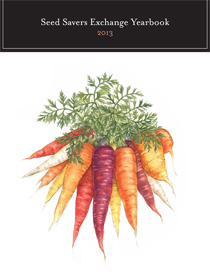Seed Savers Exchange Distributes 2013 Yearbook
/Annual publication makes available more than 12,000 heirloom and open-pollinated varieties of seed.
Decorah, IA. For the past 38 years, the Yearbook, which is distributed to Seed Savers Exchange’s 13,000 members, has grown into one of the largest private seed indexes in the United States. The Yearbook was created in 1975 in an effort to involve gardeners in the preservation of America’s garden heritage.
A non-profit grassroots organization, Seed Savers Exchange (SSE) asks its members, most of whom are home gardeners, to play a vital role as participatory conservationists in collecting, maintaining and sharing heirloom and open-pollinated seeds. Unlike hybrid seeds, the seeds of heirloom and open-pollinated varieties can be saved and grown again and will produce fruit true to the parent plant, a process used for thousands of years. The annual Yearbook is the preservation tool that fosters the sharing of seeds between SSE members.
“The Yearbook first started out as a mimeographed list of seeds shared by a handful of Seed Savers Exchange supporters back in 1975,” recalled Diane Ott Whealy, co-founder and Vice President of SSE. “Today, it is a 500 page compilation with almost 20,000 listings, ranging from Amaranth to Watermelon.”
This year SSE members have the opportunity to choose from 12,495 unique varieties from 694 listed members found across all 50 states and 12 countries. A listed member is a gardener or farmer who saves seed and offers them for exchange in the Yearbook. Each of these listed members provides an answer to what varieties perform well in their specific location: ‘Luther Hill’ corn in Ontario, ‘Speckled Butter’ bean in Mississippi, ‘Wenk’s Yellow Hots’ pepper in California, ‘Green Nutmeg’ muskmelon in Indiana, to name a few. Each variety offered in the Yearbook provides a connection between seed saver and grower.
“With the potential for climate change, the genetic variability of heirloom and open pollinated seeds has never been more important to safeguarding our future,” Whealy noted. “And the role the Yearbook and the Exchange plays is critical to providing alternatives for gardeners in an ever changing environment.” Learn more about the Yearbook and becoming a Seed Savers Exchange member here.
Located six miles north of Decorah, Seed Savers Exchange is a non-profit membership organization dedicated to the preservation and distribution of heirloom seeds. Seed Savers Exchange maintains a collection of thousands of open-pollinated varieties, making it one of the largest non-governmental seed banks in the United States. For information visit www.seedsavers.org.
For More Information, Contact:
Steve Carlson Seed Savers Exchange 563-387-5686 newsroom@seedsavers.org














